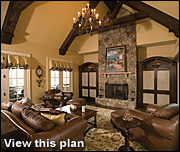 One of the great things about having a fireplace today is that you have so many incredible options so you can enjoy a cozy, warm fireplace that fits your specific lifestyle and personal preference. Just imagine your family gathering around a warm fire for S'mores or to play a board game, a romantic evening in your master suite or enjoying your outdoor living room during the colder weather.
One of the great things about having a fireplace today is that you have so many incredible options so you can enjoy a cozy, warm fireplace that fits your specific lifestyle and personal preference. Just imagine your family gathering around a warm fire for S'mores or to play a board game, a romantic evening in your master suite or enjoying your outdoor living room during the colder weather.
Before you get all fired up about all the new design options and functionalities, you need to keep in mind that having a fireplace comes with added responsibility. That means making sure someone is in the room whenever a fire is burning, having the fireplace chimney cleaned yearly to remove debris, and making sure the fireplace in general is working optimally.
Here are some of the basic styles to choose from:
The first style of fireplace is made of masonry. Typically, the firebox is made from a yellowish brick and has a brick chimney. These structures are incredibly large and can weigh up to seven tons. The nice thing about this type of fireplace is that they look great, are highly durable and will increase the value of your home.
One trend that many homeowners are turning to is adding brick around the fireplace or having new surrounds built. Keep in mind that while fireplaces are wonderful for setting a mood in a room, they are relatively ineffective for heating your home, which is why you should consider alternative fireplace options, like prefabricated.
Prefabricated fireplaces are made of metal and designed to work safely and efficiently. Because they are highly insulated they can be installed within an inch of your wall framing, which makes them very versatile for design purposes.
The great thing about using a prefabricated fireplace in new home construction is they are lightweight, easy to install, energy-efficient and very aesthetically pleasing. Some have imitation brick on the front, giving them the appearance of being a masonry fireplace while others have very clean lines, creating a contemporary look. Another benefit of this type of fireplace is that they are sold as gas burning units that can be placed in literally any room.
You can enjoy the look of an authentic masonry fireplace but without the labor of the maintaining the flames by adding a direct vent gas insert. This allows you to convert your fireplace into a fully functional heater that can heat huge rooms for a minimal cost. The way this works is that outside air is used for combustion, meaning the room does not lose any air. Now add the realistic ceramic logs and glowing embers and you have a cozy fire to enjoy.
If design is a concern, you will be happy to know that the stones for the direct vents and fireplace inserts vary in color and material. Some popular design choices are the bay front, which provides a warm and inviting appeal and the brick lining that gives an appearance of a masonry fireplace. Most people look for ways to cut back on costs, especially heating costs that have skyrocketed in the past couple of years. With direct vents and fireplace inserts, you can really cut back on energy costs.
In its simplest form, a wood stove is just a metal (cast-ironed, brick-lined or welded plate steel) container for a fire. A wood stove has an inlet for combustion air and an outlet for combustion gases - the smoke. Most models are airtight and allow the amount of combustion air that feeds the flame to be controlled, which allows it to burn more efficiently than a traditional open fireplace. In fact, wood stoves convert up to 90 percent of their fuel to heat.
When choosing a wood stove, there's a lot to consider. You want to make sure that the stove is EPA- certified. You'll find a sticker on the stove and a permanent notice on the back of the stove that lists the Btu rating, which measures the output of heat.
One common mistake people make is to purchase too powerful a stove for their home. An oversized stove is a potential fire hazard, because it's often operated in an extremely "slow fired" condition, which leads to creosote buildup and increases the risk of chimney fires. So before you go stove shopping, ask yourself two questions. How much heat should it supply? Enough for one room or the whole house? Where do you want to install it? Besides the living room or family room, wood stoves are chugging away in bedrooms, kitchens, outdoor living rooms and even bathrooms.
Another option is pellet-burning appliances, which are easier to operate and more convenient than most wood-burning appliances. In fact, they are almost as easy to use as gas, oil or electric heaters. Pellet-burning appliances use sophisticated computers and circuit boards to determine how much pellet fuel (wood pellets that resemble rabbit food) should be burned. The majority of the models come with at least two burn settings, thermostats and a forced-air system to distribute heat. Pellet-burning appliances are highly efficient and pollute very little. Many models don't even need a chimney, just a small hole in the wall to the outdoors to let out the exhaust fumes.
Because these appliances burn wood so efficiently, you don't need to refuel them as much as you do other wood-burning appliances. Refueling can vary from daily to weekly, depending on the model and your heating needs.